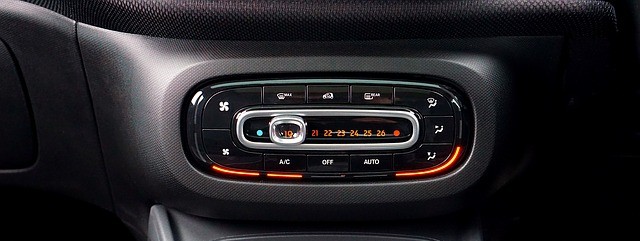
AC Distraction Issue
Air-conditioning device can easily distract drivers attention from the road, which represents a security risk. There are many efforts taken by automobile manufacturers and transport regulation authorities to minimize distracted driving. AC distraction can be fatal. The subject is now considered as mainstream while designing interiors of the vehicles.
Daimler’s Take
In 2016, Daimler recognized the problem that, while driving, drivers take longer time to adjust the AC temperature because they need to shift their focus onto the digits displaying temperature and fan speed of the AC unit mounted on the dashboard. Daimler came up with the idea based on the AC unit installed for the rooms. There is a known process for light control in artificially lit rooms. In this room, a color temperature of a white interior lighting is changed depending on a difference between a set temperature and actual temperature of the room.
The room AC light reference
Here, AC unit can control room lighting according the set temperature.If the set target temperature is higher than the actual room temperature, a warmer color temperature is selected and when the set target temperature is less than the actual room temperature, color temperature is adjusted to be cooler.
Read carefully, there is no color change, only the ‘color temperature’ change.
In such a method, based on the color temperature of the white light, it can only be known whether the AC is heating or cooling the room. You can’t guess the set temperature range. In addition, if the color temperature is adjusted only using white light, there is a big problem. Our(human) vision is designed to compensate for changes in the color temperature of a white light. That is, when the eye becomes accustomed to a specific color temperature of white light, we can’t differentiate it based on our memory. Therefore, we can only perceive the change of color temperature. After a short familiarization period, it is no longer recognizable to humans, whether a warmer or a colder color temperature is set. Therefore, we can not conclude whether the air conditioning unit is in a cooling or heating in a short time.

“If you look at one of these for longer time, you will misjudge it for wrong operational mode”
Daimler wanted another method of feedback of a temperature setting, which can be recognisable over prolonged period of driving.
Solution Concept
The use of a coloured light source to symbolise a temperature setting is preferred. Coloured light can still be perceived as a colour even after a prolonged adjustment period. So, for displaying a set temperature, a colour of lighting element(LED) is adjusted. We can easily recognise the three primary colors red, green and blue, so that is a good differentiation for temperature adjustment. In addition, mixed colors of the primary colors can be used to indicate intermediate positions in the set temperature.
Temperature Range – Effect – Color
- 16°C to 19°C – Cool – Blue
- 19°C to 22°C – Neutral – White/Green
- 22°C to 26°C – Warm – Red
Where to display these colors ?
These colors are to be displayed right where the temperature setting control is located. It can also indicate the election in which the light color is adjusted, i.e. the area for which the temperature was set. This enables the operator of the AC to easily recognize the area for setting the temperature.
Zones / Areas
- Driver side
- Passenger side
- Rear passengers space
- Seat Ventilation
- Footwell
Air Flow rate feedback
Going further in the solution, to set the fan/blower speed in the vehicle, a light is provided near every air outlet to spread light softly to indicate air flow situation. Such regions may, for example,
Sub-zones to be monitored
- Drivers side vents
- Passenger side vents
- Rear compartment vents
- Windshield vents
- Footwell vents
- Head & body portion vents
For above sub zones different temperatures can be set. As told above, the light on the particular vent can indicate its temperature range by the color effect (e.g. either Blue, White/Green, or Red).
For example, if the temperature on the drivers side vent is 18°C, vent itself will glow bluish in color. Now, for that temperature, if the blower speed is set on faster side, the intensity of that blue light will increase. Similarly, if we reduce blower speed, intensity of the blue light will come down. This way driver can recognise how AC vents are set up. Even, we can show the closed vent by unlit LED condition.
Take look around your car and you will know what’s the temperature settings immediately,
Or adjust the climate knob without reading digits,
Cool, isn’t it?
no more AC distraction issue!
The Challengers – Audi, Honda and Faurecia
Though the effort from Daimler is surfaced around November 2017, there are similar developments happening at Audi, Honda and Faurecia. Let’s take a look at them briefly.
Audi
Back in 2006 Audi’s engineers thought about this type of idea for mood lighting based on the user preference and AC parameter controlled colored lights. The interior settings for lighting can be stored in the memory device. Audi considered drive modes to determine light color inside the cabin of the car.
Honda
Honda thought of working on this with mood lighting around the AC vents in 2007. These vents glow in colored light depending upon set temperature. Difference here with Audi is the location of lights i.e. at vents.
Faurecia
In 2010, Faurecia successfully developed the concept for showing the colored ring around the AC knob. That ring/dial is made of minimum two LEDs to fill the ring with light. As those two LEDs are of blue and red in color, it shows the ring covered with the light more or less by particular shade. If the temperature is set on the more cooler side, then the ring will be illuminated more in blue light compared to the red light. Unit for percentage of light shade is differentiated by angular degrees allotted for illumination around the knob/controller.

Other related groups who were close to similar technology were General Motors, Hyundai Mobis, Valeo, Schneider etc.
Opinion
Daimler may have upper hand here because of the additional flow rate feedback system, but they can’t move alone with this technology as others have already put forth such systems partly matching the cause. Only differentiation here will be combination of one known and other innovative technique to achieve more impacting result. But it also may increase AC distraction issue by adding more lights into the cabin.
Have you thought of this AC distraction issue before ?
Can you improve this further ?
Or demonstrate it (not as easy as it looks)?

